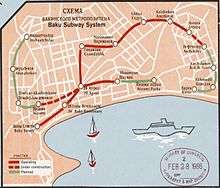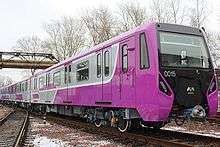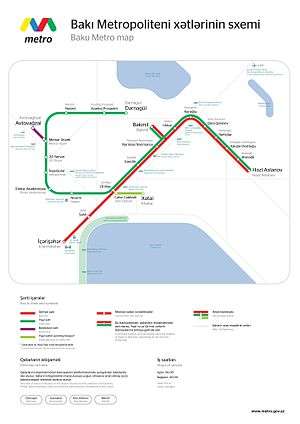Baku Metro
Baku Metro (Azerbaijani: Bakı metropoliteni) is a rapid transit system serving Baku, the capital of Azerbaijan. First opened on 6 November 1967[1] during the time of the Soviet Union, it has features typical of ex-Soviet systems, including very deep central stations and exquisite decorations that blend traditional Azerbaijani national motifs with Soviet ideology. At present the system has 36.63 kilometres (22.76 mi)[1] of bi-directional tracks, made up of three lines[1] served by 25 stations.[1] The metro is the only one constructed in Azerbaijan, and was the fifth built in the Soviet Union. In 2015, it carried 222.0 million[3] passengers,[2] which yielded an average daily ridership of approximately 608,200.
 | |||
| Overview | |||
|---|---|---|---|
| Native name | Bakı metropoliteni | ||
| Owner | Baku Metro CJSC | ||
| Locale | Baku, Azerbaijan | ||
| Transit type | Rapid transit | ||
| Number of lines | 3[1] | ||
| Number of stations | 25[1] | ||
| Daily ridership | 608,200 (daily average, 2015) | ||
| Annual ridership | 222.0 million (2015)[2][3] | ||
| Chief executive | Zaur Huseynov | ||
| Website | Baku Metro | ||
| Operation | |||
| Began operation | November 6, 1967 [1] | ||
| Operator(s) | Bakı Metropoliteni | ||
| Number of vehicles | 228 | ||
| Technical | |||
| System length | 36.63 km (22.8 mi)[1] | ||
| Track gauge | 1,520 mm (4 ft 11 27⁄32 in) Russian gauge | ||
| Electrification | Third rail, 825V DC | ||
| |||
Baku Metro Closed Joint-Stock Company (Baku Metro CJSC), the company which runs the Baku Metro, was founded according Decree No. 289 Of the President of the Republic of Azerbaijan on February 27, 2014 as a legal successor of Baku Metro and Azertunelmetrotikinti Joint Stock Company. Property along with rights and obligations of Baku Metro and Azertunelmetrotikinti Joint Stock Company were transferred to the newly established Baku Metro CJSC.[4]
History
During the final decades of the Russian Empire the port city of Baku became a large metropolis due to the discovery of oil in the Caspian Sea. By the 1930s, it was the capital of the Azerbaijani SSR and the largest city in Soviet Transcaucasia. The first plans for a rapid-transit system date to the 1930s, with the adoption of a new general plan for city development. After World War II, the population passed the one million mark. a requirement of Soviet law for construction of a metro system. In 1947, the Soviet Cabinet of Ministers issued a decree authorizing its construction, which began in 1951. On November 6, 1967, Baku Metro became the Soviet Union's fifth rapid-transit system when the first 6.5 kilometers of track and a depot were inaugurated, in honor of the fiftieth anniversary of the October Revolution.

Due to the city's unique landscape, Baku Metro did not have the typical Soviet "triangle" layout of development, and instead had two elliptical lines which crossed each other in the center of the city at the Baku Railway Terminal. Thus one line would begin at the southwestern end of the city, and cross on a northeastern axis to follow the residential districts on the northern edge of the city and then snake along to the southeastern and ultimately southern end. This was inaugurated in three stages: Ulduz (1970) and Neftçilər (1972), followed by Ahmedli (1989) and finally Hazi Aslanov (2002), completing the first line. Additionally, in 1970 a branch was opened to a station built in a depot, Bakmil.
The second line was to parallel the Caspian coast from Hazi Aslanov through Baku's industrial districts, meeting the first line again at the Baku Railway Terminal, and then continuing westwards before turning north to join Baku's northwestern districts. To accelerate construction, a branch was opened from May 28 station to Khatai in 1968, and in 1976 in the opposite direction towards Nizami. The second and first line used the same station (May 28). This posed no serious problems initially, as the line was two stations long, but when the second stage opened in 1985, lengthening the line to 8 stations (Memar Ajemi), construction of a transfer was desperately needed.
In 1993, the first stage of the transfer station Jafar Jabbarli came in operation, but the end of the Soviet Union, political unrest, military conflict in Nagorno-Karabakh and the financial collapse which followed effectively paralyzed any construction attempts in Baku. Furthermore, during the mid 1990s, three mass casualty incidents took place: on March 19 and July 3, 1994, terrorist attacks killed 27 people and injured another 91, and on October 28 of the following year a fire in a crowded train killed 289 and injured 265 others, the world's deadliest subway disaster.
In the late 1990s construction restarted. The first project was the completion of Hazi Aslanov station, partly sponsored by the European Union. In the mid-2000s, construction of the northern end of the second line, abandoned since 1994, was restarted with Nasimi station opening in October 9, 2008.
Network
Lines
| Line | Segment | Date opened | Length | Stations |
|---|---|---|---|---|
| Red | Icheri Sheher ↔ Hazi Aslanov | 1967 | 20 km | 13 |
| Green | Darnagul ↔ Hazi Aslanov | 1976 | 31 km | 19 |
| Green | Shah Ismail Khatai ↔ Jafar Jabbarly | 1976 | 2 km | 2 |
| Purple | Avtovağzal ↔ Memar Ajami | 2016 | 2 km | 2 |
Timeline
| Segment | Date opened | Length |
|---|---|---|
| Icheri Sheher – Nariman Narimanov | November 6, 1967 | 6.5 km |
| 28 May – Shah Ismail Khatai | February 22, 1968 | 2.3 km |
| Nariman Narimanov – Ulduz | May 5, 1970 | 2.1 km |
| Nariman Narimanov – Bakmil | September 25, 1970 (reconstructed in 1978–79) | 0.5 km |
| Ulduz – Neftchilar | November 7, 1972 | 5.3 km |
| 28 May – Nizami Ganjavi | December 31, 1976 | 2.2 km |
| Nizami Ganjavi – Memar Ajami | December 31, 1985 | 6.5 km |
| Neftchilar – Ahmedli | April 28, 1989 | 3.3 km |
| Jafar Jabbarly | December 27, 1993 | 0.15 km |
| Ahmedli – Hazi Aslanov | December 10, 2002 | 1.4 km |
| Memar Ajami – Nasimi | October 9, 2008 | 2.1 km |
| Nasimi – Azadliq prospekti | December 30, 2009 | 1.3 km |
| Azadliq prospekti – Darnagul | June 29, 2011 | 1.5 km |
| Avtovağzal – Memar Ajami | April 19, 2016 | 2.07 km |
| Total | 25 stations | 36.7 km |
Renaming of stations
| Old | New | Date of renaming |
|---|---|---|
| Şaumyan | Xətai | May 11, 1990 |
| 26 Bakı Komissarı | Sahil | April 9, 1992 |
| XI Qızıl Ordu Meydanı | 20 Yanvar | April 27, 1992 |
| 28 Aprel | 28 May | April 9, 1992 |
| Avrora | Qara Qarayev | April 27, 1992 |
| Elektrozavod | Bakmil | January 1, 1993 |
| Bakı Soveti | İçәrişәhәr | April 25, 2007 |
| Məşədi Əzizbəyov | Koroğlu | December 30, 2011 |
Expansion plans
At present, there are several expansion projects planned, two of which are under construction. In 2011, the Chief Executive of the Baku Metro, Taghi Ahmadov, announced plans to construct up to 53 new stations by 2030. Currently, eight stations and two train depots are under construction.[5][6][7] These will serve the new bus complex as well as Heydar Aliyev International Airport.[8]
The signalling, supervision and telecommunication systems for Phase 1 of the Purple Line will be upgraded by Thales.
Three new stations were planned to open by 2015, according to Ahmadov; Avtovağzal Bus Terminal was scheduled to open in late 2012 (delayed to 2016), while Old Gunashli and New Gunashli were planned to begin operating before 2015 (not yet open).[9]
Construction of the intermediate section of the Green Line, between Khatai and Hazi Aslanov along Nobel Avenue began in August 2013 by a French–Ukrainian consortium.[10][11]
The Baku Metro will be refitted with modern technologies. The new stations will be able to handle trains with up to seven cars. The stations will feature modern platforms, lobbies, and escalators as well as new signaling and control systems.[5]
Structural units
Baku Metro Closed Joint-Stock Company embracing such important areas like subway operation and construction, has the following structural units:[12]
- Traffic service
- Depot Department
- Tunnel Facilities Services
- Traffic Services
- Electricity Supply Services
- Electromechanical Service
- Overhaul Services
- Alarm and Communication Services
- Automototransportation Services
- United workshops
- Construction Department
- Human Resources and Services Department
- Department of Perspective Development and Capital Construction Supervision
- Department of Finance[12]
Operation
Officially Baku Metro has two lines, however due to problems with opening the second part of Cəfər Cabbarlı, Baku instead operates as a large four branch system, with trains travelling from Həzi Aslanov to either İçərişəhər or Dərnəgul, branching at May 28 (beneath the main train station). Rare services from both Dərnəgul and İçərişəhər also terminate at Bakmil but only twice per hour. There is a one-stop second line that operates separately between Cəfər Cabbarlı (essentially different platforms within the same station as May 28) and Şah İsmail Xətai, a shuttle service using only one of the two tracks due to low demand. The second interchange station is “Memar Əcəmi" where Green and Violet Lines cross.[4]
Due to the city's uneven landscape some stations are very deep, that could double as bomb shelters in case of a nuclear war attack, given that the system was built at the height of the Cold War in the 1950s/early 1960s. All seven of these deep level stations have a standard pylon design. The majority of the system's stations, 13, are shallow pillar-trispans. In addition one station, Bakmil, is a single platform surface level.
Like many other former Soviet systems most of the stations of the system are exquisitely decorated; many feature advanced Soviet motives in artwork (including mosaics, sculpture and bas-reliefs) and architecture such as those of progress and international culture, whilst others focus on traditional Azeri culture and history. After the collapse of the Soviet Union, several stations were renamed, and some of their decoration was altered to comply with the new ideology.
Ticketing
The system works on a flat fare of 30 qapik per trip, following a price hike on August 1, 2018. Some Baku residents were reportedly unhappy with the price hike, citing the age of the metro system's infrastructure.[13]Until 2006, metro users accessed the stations with metal (later plastic) tokens placed into turnstiles. In 2006 the Baku Metro introduced an RFID card system using rechargeable fare cards, which require a 2-manat deposit (plus travel credit).
BakuCard is a single Smart Card for payment on Baku Metro and BakuBus.[14] The intercity buses and metro use this type of card-based fare-payment system.[15][16]
Wi-fi and mobile phone coverage
Work to install free wi-fi service at Koroğlu station is now underway.[17]
Local mobile service provider Nar Mobile has started to provide 3G coverage at Sahil, Nəsimi, 28 May, Memar Əcəmi, Azadlıq prospekti and Dərnəgül. Service will expand to all stations as well as to tunnels by May.[18]
Rolling stock

Baku is served by one single depot, which is located next to the Bakmil surface station, and carries the same name. As of January 2005, the system had 228 cars, of which 43 five-car trains were formed, the rest used for specialist duties. The earliest set of models include the old E, Ezh, Ezh1, Ezh3 and Em-508T types, built in the 1960s and 1970s, whilst most are the 81-717/714 and their modifications which Baku has been receiving since the early 1980s.
The Baku Metro planned to purchase new trains in late 2012 from the Metrovagonmash rail car plant, near Moscow, to operate on its third line. The exact amount is not yet known, however. The trains would be built from stainless steel and equipped with air conditioners.[19] The first rolling stock of the type 81-760/761 developed by Metrovagonmash and Alstom arrived in 2014 and is currently replacing the old model 81-717/714.[20] Baku Metro opens its workshop on overhaul and modernisation of wagons.[21]
Retro carriages
On 6 November 2017, a рresentation was given of the retro carriages which were restored on the occasion of the 50th anniversary of the Baku Metro.[22] These carriages, manufactured at the end of 1934, had 52 seats and 120 standing places. Carriages of this type were sent to five cities including Moscow, Leningrad, Kiev, Tbilisi, and Baku, which received 47 carriages of this type.[23]
Incidents
1994 bombings
On March 19 to July 3, 1994, bombs killed 27 people and injured 91 others.[24] Three Armenians were later arrested, charged and imprisoned in connection with the incident.[25]
1995 fire
On October 28, 1995, a fire broke out between the Ulduz and Nariman Narimanov stations, killing 289 people and injuring 265 others.[26][27] The fire was deemed to have been caused by electrical malfunction but the possibility of sabotage was not excluded. The fire remains the world's deadliest subway disaster.[28]
See also
References
- "Baku Metro - History". Bakı Metropoliteni. Archived from the original on August 18, 2013. Retrieved September 16, 2013.
- "Ötən il Bakı metrosu ilə 222 mln. sərnişin daşınıb". ANN (in Azerbaijani). Azerbaijan News Network (ANN). 2016. Retrieved November 9, 2018.
- "Conveyance of passengers in transport sectors". The State Statistical Committee of the Republic of Azerbaijan. Retrieved May 4, 2017.
- "About "Baku Metropolitan" CJSC". railway-strategies.com. December 2016. Retrieved November 9, 2018.
- Nigar, Orujova (August 11, 2014). "Good news for Baku Metro's users". Retrieved November 9, 2018.
- "Over 70 underground stations to be built in Baku". news.az. November 4, 2010. Retrieved November 9, 2018.
- Mammadov, Anar (February 18, 2011). ""Memar Əcəmi" stansiyasında yeni metro xəttinə keçid açılır – FOTO" (in Azerbaijani). Milli.az. Retrieved November 9, 2018.
- "41 new underground stations to be constructed in Azerbaijani capital in the next 17 years". APA. October 10, 2008. Retrieved November 9, 2018 – via Day.az.
- "Number of subway stations in Baku rises". Archived from the original on 16 April 2014. Retrieved 20 December 2011.
- "Construction of new Baku metro line launched". Azeri Press Agency. August 22, 2013. Retrieved November 9, 2018.
- Orujova, Nigar (August 22, 2013). "Construction of new section in Green Line of Baku Metro starts". Azernews. Retrieved November 9, 2018.
- "About "Baku Metropolitan" CJSC". Archived from the original on June 18, 2017. Retrieved May 17, 2017.
- {{cite news|url=https://jam-news.net/public-transit-fares-raised-in-azerbaijan/%7Ctitle=Public%5B%5D transit fares raised in Azerbaijan|publisher=JAM News|date=31 July 2018|accessdate=22 May 2019|
- "Vehicles available with "BakiKart"". bakikart.az. Retrieved November 9, 2018.
- "How to pay your fare-Bakı Metropoliteni". www.metro.gov.az. Archived from the original on November 1, 2017. Retrieved April 2, 2017.
- "Ticket and Prices". www.bakubus.az. Retrieved November 9, 2018.
- "Baku Metro installs Wi-Fi at stations". APA. 16 December 2011. Archived from the original on 7 April 2012. Retrieved 20 December 2011.
- "Azerfon launched 3G in Baku Metro and announced global launch of 4G for May". Archived from the original on 4 March 2016. Retrieved 10 March 2012.
- http://abc.az/eng/news/main/60438.html%5B%5D
- "Bakı metrosunun yeni vaqonları – bizi nə gözləyir? – FOTO" (in Azerbaijani). OXU. October 31, 2014. Retrieved November 9, 2018.
- "ABC.AZ". Abc.az.
- "President Ilham Aliyev reviews retro carriages in Baku Metro". November 6, 2017. Retrieved November 9, 2018.
- "Baku Metro presents retro carriages timed to 50th anniversary [PHOTO]". November 8, 2017. Retrieved November 9, 2018.
- Atwell, Elizabeth; Khanlou, Pirouz (1995). "Baku's Metro Accident". Azer International Magazine. pp. 46–47. Cite magazine requires
|magazine=(help) - "Azerbaijani Terrorism Suspect Extradited to Baku". RFE/RL NEWSLINE. December 2, 1997.
- I.J. Duckworth. "Fires in vehicular tunnels" (PDF). 12th U.S./North American Mine Ventilation Symposium 2008. Archived from the original (PDF) on December 16, 2010. Retrieved April 4, 2010.
- Terje Andersen, Børre J. Paaske. "Railroad and Metro Tunnel Accidents". Lotsberg.net. Retrieved November 9, 2018.
- Phil Reeves (October 31, 1995). "Sabotage fear over metro fire". The Independent. Retrieved November 9, 2018.
External links
| Wikimedia Commons has media related to Baku Metro. |
- Baku Metro (in Azerbaijani, English, Russian, and French)
- Urbanrail - Baku Metro
- Baku Metro Track Map (in Russian)
- Interactive Baku Metro Map
- More information (in Russian)
- Baku Public Transportation
